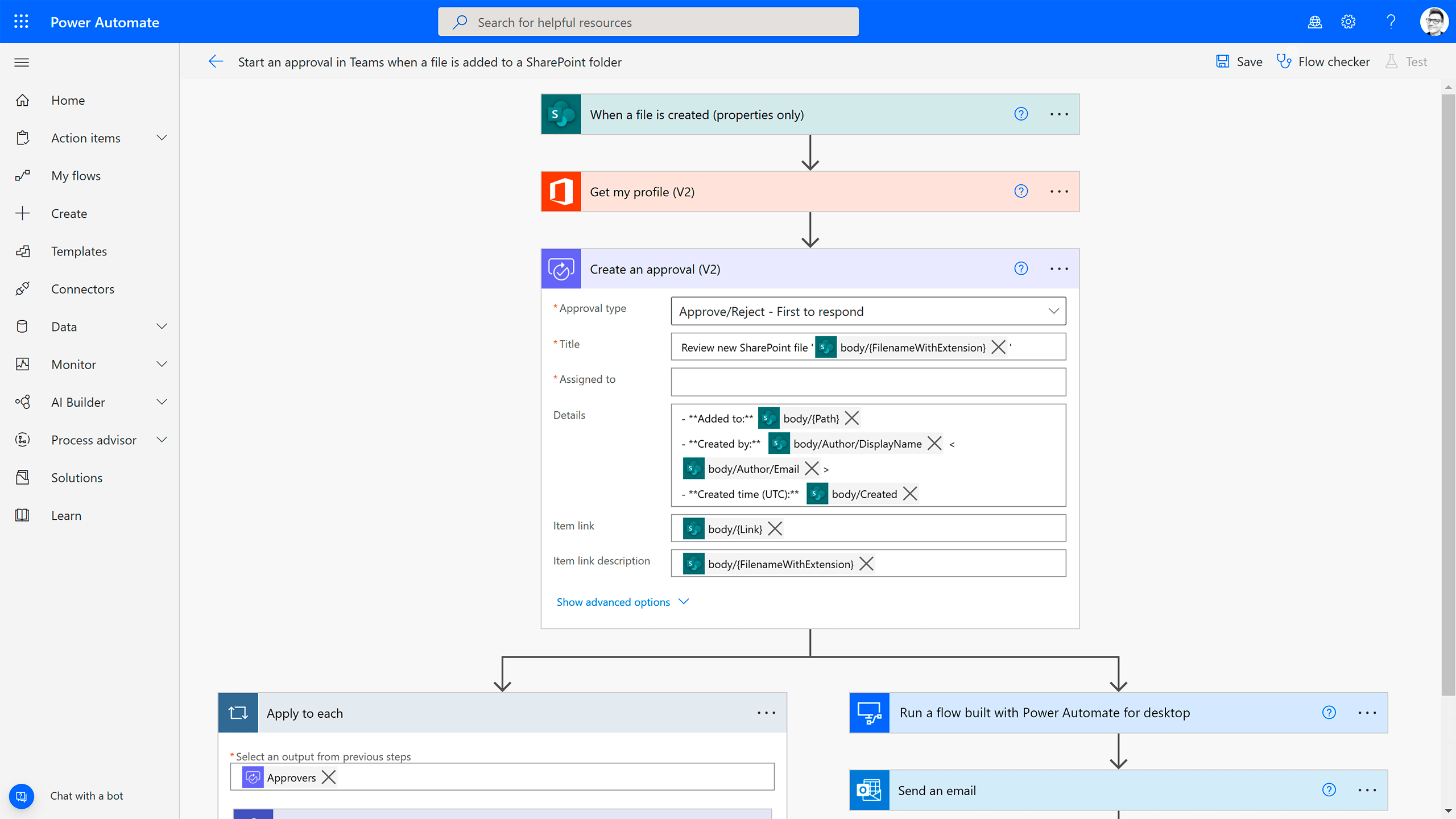Microsoft is continually working to improve its IT solutions to modernize all business processes. Integral products for automating any routine tasks are MS Dynamics Workflow and Power Automate. In this article we will examine in detail the differences between these solutions.
Power Automate
Power Automate (formerly Microsoft Flow) is a service that helps you create automated business processes between frequently used applications and services. These processes can be used to sync files, receive notifications, collect data, and other purposes. The app is available to customers with a Microsoft 365 subscription and a free Microsoft account. The platform allows users to automate workflows and access them from any device with an Internet connection thanks to cloud technologies.
Power Automate can be used to create workflows and set event-based triggers for specific actions. The service works with various Microsoft application suites such as SharePoint, Office 365, OneNote and many other third-party services such as WordPress, Google Drive and others. Power Automate makes it easy for companies to manage their processes by automating things like simple push notifications to trigger events. In other words, if you want to create a workflow with email received through Outlook as a trigger event, Power Automate will come in handy.
Along with the standard automated workflows that Power Automate can create, the service also offers various flows tailored to specific situations:
Automated flows: automatically starts a chain of sequential actions or events when a trigger is fired.
Mobile streams: Performs repetitive actions on employee mobile devices.
Scheduled threads: automates actions and tasks that need to be performed with specified regularity.
Business Process Flows: Planned actions for specific employees.
Microsoft offers a huge number of ready-made automation templates in various areas that you can customize to suit your needs. Templates make it easy to run many common corporate procedures, from email to data collection. Users can also easily create their own flow from scratch and customize it to suit specific business requirements.
Pros of use Power Automate Flows
- Creates streams and connectors for cloud and local services without writing code.
- Efficiently configures scheduled jobs, UI flows, and business process flows.
- Improves business processes and productivity by minimizing errors
- Enables you to realize the value of connected Microsoft solutions and tools.
- Increases workplace security as all apps built on the Power platform are GDPR compliant.
- Allows you to implement data-driven decisions

Dynamics 365 Workflows
Dynamics 365 Flows is an automation tool that allows you to create workflows and configure event-based actions. This helps simplify tracking and collection of data at various stages of the workflow. It is a cloud-based tool that can be accessed by anyone authenticated to use Dynamics 365 services. Workflows are typically used in conjunction with Dynamics 365 to automate CRM and Customer Engagement services.
Dynamics 365 Customer Engagement offers the ability to generate streams in real time or asynchronously. Asynchronous processes happen in the background, allowing you to use CRM and other programs while the process is running without disrupting ongoing activity. Real-time requires completion of one operation before moving on to the next. In most cases, asynchronous processes seem to be the best option; they work in the background, allowing you to perform other tasks without stopping all work. However, real-time processes can be useful for operations that need to be completed urgently.
Dynamics 365 Workflow has features that allow you to automate many routine operations. Flows can be useful for CRM solutions because they use a trigger event to control the next steps. Workflows help you maintain ongoing communication with your customers and improve their experience with your company, as well as record the entire journey from first contact to purchase.
With the Dynamics 365 Workflow tool, you can easily set up, for example, placing an order for equipment - this is a fairly well-defined process that includes various steps such as checking inventory, placing order requests, getting manager approval and then processing the order request . For each step of this process, a workflow is set up with structure and details. Appropriate events are programmed to trigger the next course of action and save time spent manually monitoring the process.
Pros of using Dynamics 365 Workflow
Dynamics 365 Workflow simplifies routine tasks such as creating and updating records whenever a certain event occurs. For example, once an order is processed, you can set up a workflow to automatically update the corresponding customer record.
- Automates email notifications and alerts
- Speeds up approval processes
- Improves productivity and minimizes errors
- Simplifies data operations
- Increases employee satisfaction

Comparison Dynamics 365 Workflow And Power Automate Flow: basic differences
The Power Automate app can be used with an MS 365 subscription and easily integrates with third-party apps. At this time, the functionality of Dynamics 365 is tied to the Dynamics CRM platform and therefore can only be used in CRM applications.
Dynamics Workflow is configured to enable automation in Dynamics 365 CRM. You can use triggers for CRM operations such as updating, deleting, and changing fields. You can configure a wide range of actions, such as updating and adding records, changing the state of a record, starting a workflow, applying conditional logic, and much more. Although Power Automate provides similar trigger functionality, you can only use predefined triggers for a specific application. Additionally, you will be provided with limited predefined actions depending on the target application.
Dynamics 365 Workflow and Power Automate: which to choose?
If you are working on complex workflows on the Dynamics 365 platform, the best solution is to use Dynamics 365 Workflow. Moreover, if all your actions, trigger and data are inside a CRM system, it makes sense to use a CRM workflow.
But if you want to run actions based on triggers or apply actions to external applications outside of the Dynamics 365 platform, you can use Power Automate. Additionally, Power Automate comes with ready-made workflow templates that you can use instead of starting from scratch.
Not sure which solution is right for you?
Finding the best solution for a given task can be a challenge. You need to consider your needs to develop customized solutions that make the best use of Microsoft software. For expert help on making full use of Power Automate and Dynamics Workflow tools, just contact us. We at Fanetech help businesses in Kazakhstan implement Microsoft technologies and use them on 100%.

